| |
"It's the kind of screenplay that right from the beginning people either got or didn't get, and that's been true of the whole journey of the film ever since. You either buy into what the experience is or you don't and you can't really be persuaded to." |
| |
Writer-director Philip Ridley |
Now here's an opening scene that we all remember. On a quiet, sun-drenched dirt road in 1950s rural Idaho, young Seth Dove and his mates decide to hatch an unpleasant prank on local English widow Dolphin. This involves inflating a frog (don't ask how) and placing it in the road, and when Dolphin bends down to examine this most peculiar sight, an uncannily accurate catapult shot from the unsteady Seth causes it to explode, showering Dolphin's face with frog blood.
Seth lives with his father and mother in an out-of-the-way homestead that is host to a run-down gas station that probably only sells a few litres a year to desperate drivers who have lost their way. Seth's religious mother is wound up and angry at just about everything, while his easy-going father likes to pass his time reading vampire novels and is harbouring a guilty secret from his past. Ordered by his mother to apologise to Dolphin, Seth nervously pays her a visit, but a combination of her words, her expressive grief at the death of her husband, and his father's description of his current reading material convince Seth that Dolphin is actually a vampire. Thus imagine his horror when his older brother Cameron returns home from military service and quickly falls for this mysterious woman.

Coming-of-age stories are fond of having the journey from childhood to adolescence driven forward in sharp jolts by a specific set of catalysts, such as the death of a loved one and a first taste of sex, whether it be a furtive kiss or unexpectedly catching sight of your parents in the sack. In such tales, the transition from boy to man (or indeed girl to woman) is rarely if ever gradual or free of serious trauma. That's not because it never happens that way but because untroubled childhoods make for uninteresting cinema, or so the thinking goes. The most beloved of such stories, at least their film incarnations, stand out from the crowd through the strength of their characterisation and the essential truth of their observations. But just occasionally a film takes a different tack, one that doesn't so easily lend itself to instant acclaim.
The Reflecting Skin, the feature directing debut of The Krays' scriptwriter Philip Ridley, is a prime example. Adored by some and criticised by others as an unevenly acted exercise in style over content, it's a film that I first caught on its theatrical release and all these years later am still not sure quite how I feel about it. It is, after all, almost the complete antithesis of the more social realist, coming-of-age stories with which I have connected over the years. Every aspect of The Reflecting Skin feels carefully crafted and deliberately artificial, an artistic re-interpretation of coming-of-age tropes in which events are viewed exclusively from a child's point of view but presented through a distinctly adult eye for symmetry, colour, composition and lighting. But then Ridley is not telling a coming-of-age tale in the traditional sense but – as he states in the accompanying special features on this disc – a modern fairy tale, one whose young protagonist has been damaged by his geographical isolation and the fundamentalist fury of his demented mother. Ridley was clearly never in the market for realism and instead aimed to portray this corner of rural Idaho as how an older Seth might recall it in his distorted memories, albeit through an aesthetic informed by more adult influences. The landscape and even the weather thus play a largely symbolic role, a picture-book view of home in which the skies are always blue, the wheat is rich and golden and the world is always lit by the setting sun.
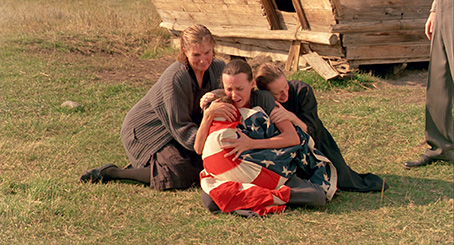
Yet there are dark deeds afoot, and as local children start to disappear and turn up dead, the eyes of local lawmen turn on Seth's seemingly good-natured father Luke, a man whose past homosexual leaning in a community intolerant of such deviation from the fundamentalist norm make him an instant candidate for possible paedophilia. When delicately questioned on his father's behaviour by the district's one-handed, one-eyed and half-eared sheriff (the sequence in which he explains to Seth how these injuries came to be is a riot), Seth assures him that he knows nothing of it, but is he telling it like it is or repressing something his upbringing prevents him from comprehending? No hints are provided and no judgement is made, though this reawakening of the past has an ultimately devastating effect on the accused Luke.
The film's refusal to confirm how much of what we are watching is meant to be taken as verbatim does leave almost everything open to speculation and makes it hard to be certain which elements are meant to be read purely in metaphorical terms. A case in point is the group of four leather jacketed greasers who glide onto the property in a black Cadillac Fleetwood and are friendly to Seth in a way that goes a step beyond that of an adult being pleasant to the cute gas station kid. Later, it seems clear that it is they who are abducting and doing who knows what to the local children, yet despite sticking out like a freshly hammered thumb in a district where anyone who sees them will instantly recognise them as outsiders, the cops seem blissfully unaware of their existence. Which of course prompts the question of whether the car and its occupants are real or a figment of Seth's imagination, and if so we're forced to ask what that implies about their final appearance and, by association, what terrible truth lies behind the actions for which we assume they are responsible. This in turn casts Seth's final screams of despair and self-realisation in a very different and considerably more troubling light.
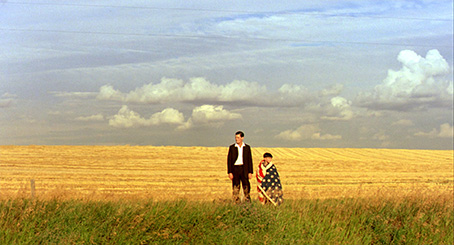
Visually the film is consistently stunning, with Dick Pope's gorgeous magic hour cinematography enhanced by further saturating the colour in post-production, giving the imagery an almost dreamlike appearance (albeit one that just occasionally has the feel of a lushly shot commercial). Less effective for this particular viewer is the extension of this carefully crafted air of unreality into some of the dialogue and line delivery, which results in whole sequences where I found myself acutely aware that I was listening to actors delivering scripted lines. Yet in spite of this, almost all of the performers still have their moments. As Dolphin, Lindsay Duncan has that very precise English middle-class way of speaking that I only ever seem to encounter in movies, but even behind her dark glasses she can be suggestively expressive, notably the cheery but somehow still demonic grin she flashes Seth towards the end of the film. As Seth, Jeremy Cooper says far more with his eyes than with his sometimes uncertain dialogue, and while a young Viggo Mortensen may be so low-key on his return from military service that you may need to up the volume to clearly hear what he says, the sense that he is carrying the weight of what he witnessed following the atomic bomb drops on Japan is evident from his facial expressions and body language alone.
Many have compared the film to the work of Blue Velvet era David Lynch, but I just don't see it. Lynch creates realistic worlds into which the surrealism of nightmares has corrosively bled and where evil steps out of the shadows and walks in plain sight, and tends to tell his stories from an exclusively adult viewpoint. The Idaho of The Reflecting Skin, however, is a picture-book fantasy viewed through the distorted memories of childhood, one in which evil certainly lurks but remains hidden from view. And where Lynch employs music to disturb and heighten the sense of waking nightmare, Nick Bicât's lush orchestral score for the Reflecting Skin is so emotionally expressive that it sometimes borders on overstatement, employed as it is to transform small moments into borderline epic events, doubtless in keeping with their subjective importance to the boy through whose eyes the story is being told.
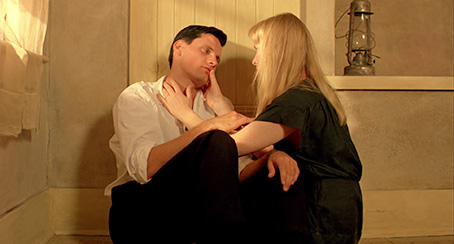
That quote at the top from director Philip Ridley was deliberately chosen, in part because I find myself questioning the suggestion that those who like the film understood what he was trying to do and those who didn't like it did not, whereas in fact it's perfectly possible to understand a director's intentions but take issue with aspects of how they are realised on screen. And after all I've written above, I'm still undecided about a work that plenty of others have enthusiastically embraced. There's much to applaud here, with individual sequences impeccably handled (the build-up to a self-immolation that we never actually see is seriously unsettling and the timing of the edit that brings this sequence to a close borders on genius), and visually the film is like no other I can readily recall. Some aspects of its meticulously crafted artificiality did ultimately keep me at a distance from characters that found myself dispassionately observing rather than forming an emotional or even empathic connection with. Yet like a complex and artistically adventurous jigsaw puzzle whose pieces do not always slot smoothly into place, the small frustrations of its construction are ultimately overshadowed by the ambition, originality and dark, sun-drenched beauty of the resulting picture.
If there is a modern film that needs to be carefully and accurately graded for its Blu-ray transfer it's The Reflecting Skin, as evidenced by the extracts from the poorly graded German Blu-ray release included in the making-of featurette on this very disc. The good news is that Philip Ridley was directly involved in the restoration and that he resisted the temptation offered by modern digital colour grading to play creative new games with his original vision. The great news is that the results are just superb, with the golden wheat fields and vibrant blue skies vividly captured here (trust me, even the included screen grabs do not do justice to how lovely the film looks on a large and decently callibrated screen), the contrast is sublimely pitched and the picture detail crisp with no trace of distracting image enhancement. What really struck me is how filmic the image looks here, which sings a hymn to the beauty of Dick Pope's cinematography. If there's a dust spot present I must have missed it and there's absolutely no movement of the image in frame. Wonderful.

The Linear PCM 2.0 stereo track is also in fine shape, boasting a strong dynamic range which allows the more emotive elements of Nick Bicât's score to really shine. Dialogue is also cleanly reproduced and there's not a hint of background hiss or damage. Bass and treble response are both hugely impressive for a non-surround track.
You can also play the film with an isolated music track (this also sounds great) and optional English subtitles for the hearing impaired are available.
Commentary
Fond though I am of director's commentaries, they only really deliver if the director in question is comfortable with the process and is happy to talk about his or her film, and I've encountered few such commentaries in recent years where the filmmaker is so enthusiastic for the process as Philip Ridley is here. Requiring no external prompting and barely pausing for breath, he shares a wealth of information on the making of a film that was clearly remains very special to him. We get breakdowns of how specific shots and sequences were filmed, information on the lighting, locations and set dressing, the battle the crew had with sometimes appalling weather, the artistic influences on individual elements (which range from painter Andrew Wyeth to Dadaist Max Ernst), the selection of cast members and a whole lot more. He openly admits the use of "sledgehammer symbolism" and justifies its use, and even provides some hints on ways that more ambiguous elements could be read, confirming my own view of one of them by linking it (very smartly) with a similarly handled component of Jennifer Kent's recent The Babadook. One of my favourite revelations is that for some shots Ridley used to get up early to paint wheat that wasn't quite as golden as he wanted. A terrific extra that really does aid your appreciation of what Ridley set out to achieve.
Angels & Atom Bombs: The Making of The Reflecting Skin (43:41)
Built around interviews with writer-director Philip Ridley, cinematographer Dick Pope, actor Viggo Mortensen and composer Nick Bicât, this useful and enjoyable look back at the making of the film (made, I believe, specifically for this release) has its share of gentle backslapping, but this appears to be largely because everyone really enjoyed their time on the production and were tuned to Ridley's vision from an early stage. Ridley is the principal contributor here, but depending on the order in which you explore the extra features you may find you've already heard most of what he says on the commentary track. It matters not, as he is able to expand on a couple of points here (the shooting of the finale is covered in more detail, for example) and the input of the other contributors offers some alternative viewpoints on the elements explored. Pope in particular is full of enthusiasm for a film he clearly relished making, while Mortensen echoes his character by being almost as reserved here as he is in the film.
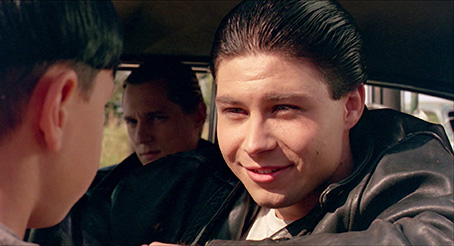
Dreaming Darkly (16:14)
Shot in tandem with the above featurette, here Philip Ridley discusses the production of follow-up feature The Passion of Darkly Noon, with contributions from actor Viggo Mortensen and composer Nick Bicât. It's great to get a peek as some of Ridley's paintings and photos, though the decision to play large chunks of the songs from the film – which were composed by Ridley and Bicât – will require some patience if you're not a fan. Stick with the end credits for a postscript story from Mortensen.
Visiting Mr. Beak (1987) (21:08 – 24:37 with Philip Ridley introduction)
A boy walks through his neighbourhood with something cupped in his hand to deliver to a man named Mr. Beak, and on the way is accosted by three wayward individuals who are each trapped in their own disconnected reality bubbles. A more openly surrealist work than the main feature, it has a number of stylistic and thematic elements that would be developed in The Reflecting Skin. Although shot on 35mm film, the original has been lost and this has thus been sourced from a VHS transfer and is thus not pristine, but still a valuable inclusion. Can be played with or without an introduction from the director, which I'd definitely watch before your first viewing.
The Universe of Dermot Finn (1988) (11:16, 13:17 with Philip Ridley introduction)
If you thought the previous film was surrealistic (and I did), then wait until you get a load of Philip Ridley's follow-up short, which was made as part of Channel Four's Short and Curlies. A young man visits his new girlfriend for dinner and finds himself sitting with her family at a table in a giant bird's nest and served a selection of raw and unprepared fish. In physically better shape than its predecessor, it's a strikingly realised and more genuinely nightmare influenced piece that is also accompanied by an optional Philip Ridley intro.
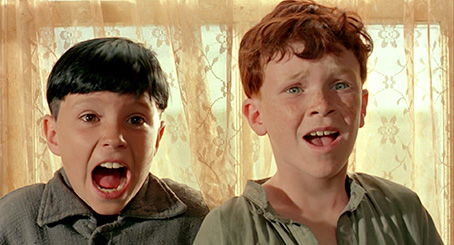
Stills Gallery (7:36)
A rolling gallery of press shots from the film by Douglas Curran. The quality does vary but there are plenty of images.
Poster and Video Art Gallery (1:51)
Posters and covers from various countries for the film's theatrical and home video releases. It ends on an image on this Steelbook edition.
Theatrical Trailer (2:24)
An intriguing sell, presented in 4:3 and drawn from what looks like a low band source, that's scored in a way to suggest a more overtly sinister film than it actually is. Seductive, nonetheless.
Re-release Trailer (2:26)
Essentially the same trailer but re-edited from the restored transfer at 1.85:1 and with some of the title cards from the original replaced by enthusiastic critical quotes.
Opinions have certainly differed on The Reflecting Skin, but in recent years the weight of critical opinion has championed it as a visionary film and I've even seen it labelled a masterpiece by some. It's certainly a visually striking and imaginatively devised and executed work that sticks in the mind and absolutely deserves to be seen by a wider audience than it found on its initial release. I'm still not quite as sold on Ridley's cinematic vision has many others have been, but admire the hell out of what he achieved on what was very likely a modest budget, and if you're going to see the film then this impressive release from Soda Pictures is currently the only way to go, boasting as it does a delicious transfer and an excellent selection of special features. For all my personal uncertainties, this still comes highly recommended.
|